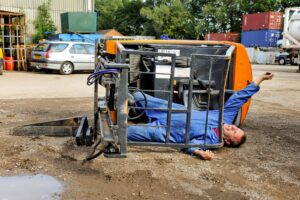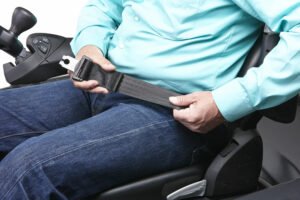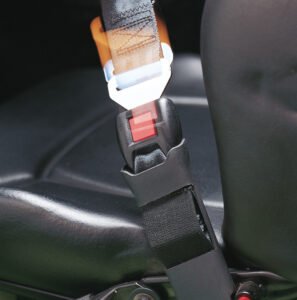What causes forklift tip-overs and how you can make things safer?
 Forklift tip-over was the focus of the UK’s inaugural Forklift Safety Day. And with good reason.
Forklift tip-over was the focus of the UK’s inaugural Forklift Safety Day. And with good reason.
According to the European Agency for Safety and Health at Work (OSHA), tipping accidents are biggest single cause of fatalities (42%) among forklift operators.
In almost every case, the driver was ‘mousetrapped’ between the truck’s overhead guard and the ground, causing terrible injuries to the head and upper body. Stewart Gosling of Red Diamond Distribution (RDD) — UK distributors of Mitsubishi Forklift Trucks — sets out the causes and what you can do to prevent it happening to your operators.
FACT: It takes around one second from the moment a truck starts to tip… to the moment the overhead guard crushes the operator.
As a tipping incident unfolds, the operator feels that everything is happening quite slowly – and that jumping clear is the obvious thing to do. To them, the leap to safety is short and the escape route is large. But in reality, things are very different. In split seconds, the overhead guard accelerates rapidly, all the time pivoting away from the operator. This greatly increases the distance required to jump clear whilst dramatically shortening the time to succeed.
The best course of action – by far – is for the operator to stay securely in his or her seat. In all likelihood they would suffer bruising and little else. It seems, though, that the human brain is hard-wired for flight and no amount of training, experience or knowledge can prevent the urge to escape.
Fortunately, one of the world’s leading forklift truck manufacturers has developed new and deceptively simple technology to ensure the operator stays safely in place: a “no-cheat” seat belt/restraint.
But more of that later. Let’s look first at what can be done to prevent tip overs in the first place… and then move on to measures designed to protect operators once it’s happening.
Taking these in order… prevention starts with a risk assessment specific to your site, loads, equipment, etc. and creating safe systems of work to eliminate hazards or minimise the risk associated with them.
Common causes of forklift truck tip overs
- Sudden turns, especially when unladen
- Sharp changes in speed or direction
- Driving too fast
- Driving off the edge of a loading bay, ramp, dock, etc.
- Driving with the load raised
- Hitting a kerb, pothole or debris (such as a broken pallet)
- Driving with an excessive, uneven or swinging load
- Turning on or traversing across a ramp or slope
- Driving downwards with the load in front
- Turning with the load raised
- Driving on an uneven surface
Many of these can be addressed by removing, re-modelling or reversing routes that require trucks to travel down slopes (especially while laden), eliminating uneven surfaces and keeping ground conditions in good order (so no potholes or debris). It’s also worth talking to your forklift provider to discuss ways to make trucks inherently safer with speed limiters, load sensors, etc.
Every bit as important, though, is appropriate and on-going training covering the three essential elements: Basic, Job Specific (off the job) and Familiarisation (on the job).
And, while we’re on the subject of training, it doesn’t end with operators. The HSE demands that if you supervise materials handling operations you must have the necessary training and knowledge to recognise what good (and bad) practice looks like. The good news is that Managing Forklift Operations courses are now available online to minimise time off site.
Minimising consequences… saving lives
 Major manufacturers strive to make equipment safer and it’s here where Mitsubishi Forklift Trucks has proved pioneers. Among its award-winning technologies developed to protect operators (as well as loads) the company has introduced:
Major manufacturers strive to make equipment safer and it’s here where Mitsubishi Forklift Trucks has proved pioneers. Among its award-winning technologies developed to protect operators (as well as loads) the company has introduced:
Intelligent Cornering System
State-of-the-art software that prevents tipping by seamlessly adjusting the truck’s speed as it enters a turn, taking into account the steer angle and load. The result is reduced risk of tip-overs, less load shedding and improved productivity as the manoeuvre is completed at optimum speed.
Intuitive performance
Intuitive handling that learns from driver inputs has so far been the province of high-end electric cars. Not any longer… Mitsubishi forklifts analyse operators’ driving styles and automatically adjust operating characteristics to ensure smooth, safe and personalised performance for pitch-perfect outputs.
Automatic speed reduction
Because driving with the mast raised is the single biggest cause of truck-tip events, Mitsubishi forklifts incorporate automatic driving speed reduction where the mast is raised above the first mast stage.
But when it comes right down to it, the biggest game-changer is the humble seat belt/lap restraint.
Wearing one at all times is the simplest and most effective way of avoiding serious injury in a tipping incident. And it’s the law. The HSE makes clear it will “Prosecute site operators who do not take adequate measures to enforce the wearing of seat belts.”
“Operator preferences and frequency of exit/entry to/from the truck do not justify not using the restraint.” British Industrial Truck Association (BITA)
The challenge lies in getting operators to comply.
Even where management is vigilant and issues constant reminders, it’s not uncommon for operators to avoid wearing a seat belt (even where there is an interlock), tricking the machine by fastening the seat belt permanently behind them. So what’s to be done?
The “no cheat” seat belt
 The good news is that Mitsubishi Forklift Trucks has introduced a “no cheat” seat belt on its latest electric counterbalance trucks. This switchable function allows the employer – at his or her discretion – to select an option that ensures wearing of a seat belt is mandatory.
The good news is that Mitsubishi Forklift Trucks has introduced a “no cheat” seat belt on its latest electric counterbalance trucks. This switchable function allows the employer – at his or her discretion – to select an option that ensures wearing of a seat belt is mandatory.
To enable the truck to drive the forklift, four steps must be followed:
- Sit on the seat (to activate the seat switch)
- Turn on the ignition
- Fasten the seat belt to (activate the seat belt switch)
- Select direction of travel
The truck can then be driven normally. If, however, if the sequence has not been completed or if the operator has tried to circumnavigate it, the machine will not function.
Sometimes, the simple stuff can have the greatest impact.
Approaches to managing the risks associated Musculoskeletal disorders
In this episode of the Safety & Health Podcast, we hear from Matt Birtles, Principal Ergonomics Consultant at HSE’s Science and Research Centre, about the different approaches to managing the risks associated with Musculoskeletal disorders.
Matt, an ergonomics and human factors expert, shares his thoughts on why MSDs are important, the various prevalent rates across the UK, what you can do within your own organisation and the Risk Management process surrounding MSD’s.

 Forklift tip-over was the focus of the UK’s inaugural Forklift Safety Day. And with good reason.
Forklift tip-over was the focus of the UK’s inaugural Forklift Safety Day. And with good reason. Major manufacturers strive to make equipment safer and it’s here where Mitsubishi Forklift Trucks has proved pioneers. Among its award-winning technologies developed to protect operators (as well as loads) the company has introduced:
Major manufacturers strive to make equipment safer and it’s here where Mitsubishi Forklift Trucks has proved pioneers. Among its award-winning technologies developed to protect operators (as well as loads) the company has introduced: The good news is that Mitsubishi Forklift Trucks has introduced a “no cheat” seat belt on its latest electric counterbalance trucks. This switchable function allows the employer – at his or her discretion – to select an option that ensures wearing of a seat belt is mandatory.
The good news is that Mitsubishi Forklift Trucks has introduced a “no cheat” seat belt on its latest electric counterbalance trucks. This switchable function allows the employer – at his or her discretion – to select an option that ensures wearing of a seat belt is mandatory.